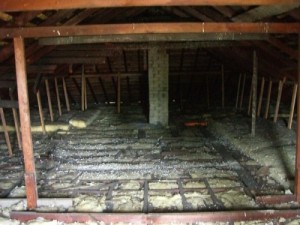
Bathroom Exhaust Fan Vented To The Attic
One of the most common causes of black mold in the attic is from improperly vented bathroom exhaust fans. If the builder, contractor or homeowner ran the bathroom exhaust fan into the attic — rather than venting it outside — the moist, humid air from the bathroom will simply go right up into the attic; thus, offering the perfect breeding grounds for toxic black mold.
You have to remember that the entire purpose of a bathroom exhaust fan is to prevent mold and mildew from growing in the bathroom, but venting it to the attic simply moves this problem into another part of your home. Using an exhaust fan is definitely the preferred method for keeping a bathroom mold-free, but you need to make sure it’s vented outside.
Blocked Attic Ventilation
Of course, blocked attic vents may also encourage the growth of black mold. If your home was built with an attic vent, perform a quick inspection to determine whether or not it’s blocked. Cellulose or fiberglass insulation may have gotten sucked into it, forcing it to stop. If there’s a visible blockage in your attic vent, make sure the power is cut before attempting to remove it. Once the blockage is removed, the attic vent should work to pull the moisture out of your attic.
Roof Leaks
Have you noticed water piling up in your attic during or after a rainstorm? Even small leaks can allow enough water in to the attic to product toxic black mold. This is why it’s important for homeowners to routinely inspect their roof for leaks, fixing any that you come across.
Thermal Leaks
Lastly, thermal leaks between your home’s attic and exterior may also contribute to the growth of toxic black mold. Even if there’s no water coming it, moisture vapor from the air will inevitably make its way through, which in turn creates breeding grounds for toxic black mold.

